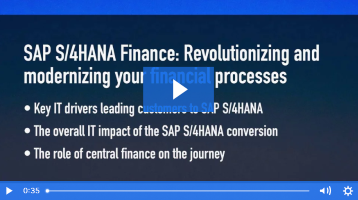Live from SAPinsider Studio: Paul Ovigele of ERPfixers on S/4HANA and Universal Journal
Paul Ovigele, founder of ERPfixers, joins SAPinsider Studio at the SAPinsider FIN-GRC event to discuss the impact the Universal Journal in SAP S/4HANA Finance has for reconciling accounts-based vs. costing-based CO-PA tables with the general ledger.
This is an edited transcript of the discussion:
Ken Murphy, SAPinsider: Hi, this is Ken Murphy with SAPinsider. I am at the SAPinsider Financials 2016 event in Las Vegas. This afternoon, I am pleased to be joined by Paul Ovigele, who is the founder of ERPfixers. He is here today to talk to us a little bit about SAP S/4HANA Finance and the Universal Journal. Paul, thanks for joining us today.
Paul Ovigele, ERP Fixers: Thanks for having me Ken.
Ken: I was hoping to start, if you could address how significant an evolution it is to have a single one line-item table in a Universal Journal with a full detail and components?
Paul: I think it’s very significant. I think when I used to – about 10 years ago, I have a lot of clients who’ve had so many problems trying to reconcile the different modules in the FI-CO space with the general ledger. And now with the Universal Journal you have the Fixed Asset module, the CO module, the CO-PA module, and the Material Ledger module all in one table. So I think it’s a pretty huge deal.
Ken: One of the things you’ve written about is for companies considering a migration to S/4HANA, that CO-PA in S/4 is accounts based, rather than cost-based. I’m wondering why that is if most companies run a costing-based version?
Paul: That’s a good question. The reason is because costing-based CO-PA uses value fields, while accounts-based CO-PA uses general ledger accounts. So it was an easy integration to have account-based CO-PA in the same table as the general ledger rather than costing-based CO-PA. So that’s even though most companies use costing-based, it just was easier to have account-based in the same table in the Universal Journal table.
Ken: So what does that mean for a business using a costing-based version of Profitability Analysis and the steps they need to take to run accounts-based CO-PA?
Paul: So for a business using costing-based, you can still stay on costing-based, but in order to have CO-PA integrated with a Universal Journal, you also have to activate account-based CO-PA. You can actually run them together but only one will be integrated with another component such as the general ledger or CO and the other tables in the Universal Journal.
Ken: So you can use both – what challenges then does that present to use a dual version?
Paul: To use a dual version, I can think of a couple of challenges. One of them is that with a dual version you have more data in your table, because account-based and costing-based populate two different tables. So you’re just having more data in your system. And then the second thing I can think of is that it might be a little confusing is you have both account and costing-based. If someone says, “Can you run a CO-PA report?” which one do you run?
Ken: So do the benefits of S/4 warrant transitioning to an account-based version for the company that’s satisfied with their current costing-based approach?
Paul: I think so. Over the years, I’ve had so many complaints about not being able to reconcile CO-PA to the general ledger. That’s costing-based CO-PA to the general ledger. And the amount of processes that need to take place at month-end in order to reconcile, it takes so long that I think even with the extra steps needed to set up account-based CO-PA, I think is definitely worth it.
Ken: Beyond that, on the flip side, are there any other sort of disadvantages to running account-based CO-PA?
Paul: There are some disadvantages, and I think these disadvantages are the reason why I think if you use costing-based CO-PA for these things you might want to keep it. One is that with account-based CO-PA, you’re not able to have statistical conditions mapped into the account-based CO-PA table. Account-based CO-PA only gets the data from the general ledger. With costing-based CO-PA if you have accruals, a statistical condition, even though they don’t have general ledger accounts you can still map that in. So that’s one disadvantage. Another one is, with costing-based CO-PA you can do re-postings to CO-PA only and some transactions like KE4S, KE4SMM. But with account-based CO-PA, if it didn’t come from the general ledger, you can’t get it in there. So that’s another disadvantage.
Ken: Lastly, Paul, what other questions are you hearing from your clients what S/4HANA brings and the differences that it might have for an organization’s finance team, accounts, and account reconciliations?
Paul: With S/4HANA, everybody is interested. Everyone is interested in what exactly does this mean to our current SAP platform? They know a lot of the benefits of S/4HANA, but they want to know how much pain is it going to be to go from where they are to S/4HANA. They’ve done a lot of work to get their system stabilized and the way they want it, but going over to a totally brand new system obviously that fear of the unknown takes place. So that’s a lot of what I’m hearing from my clients.
Ken: Paul, thank you for joining us today.
Paul: Thank you very much Ken.






